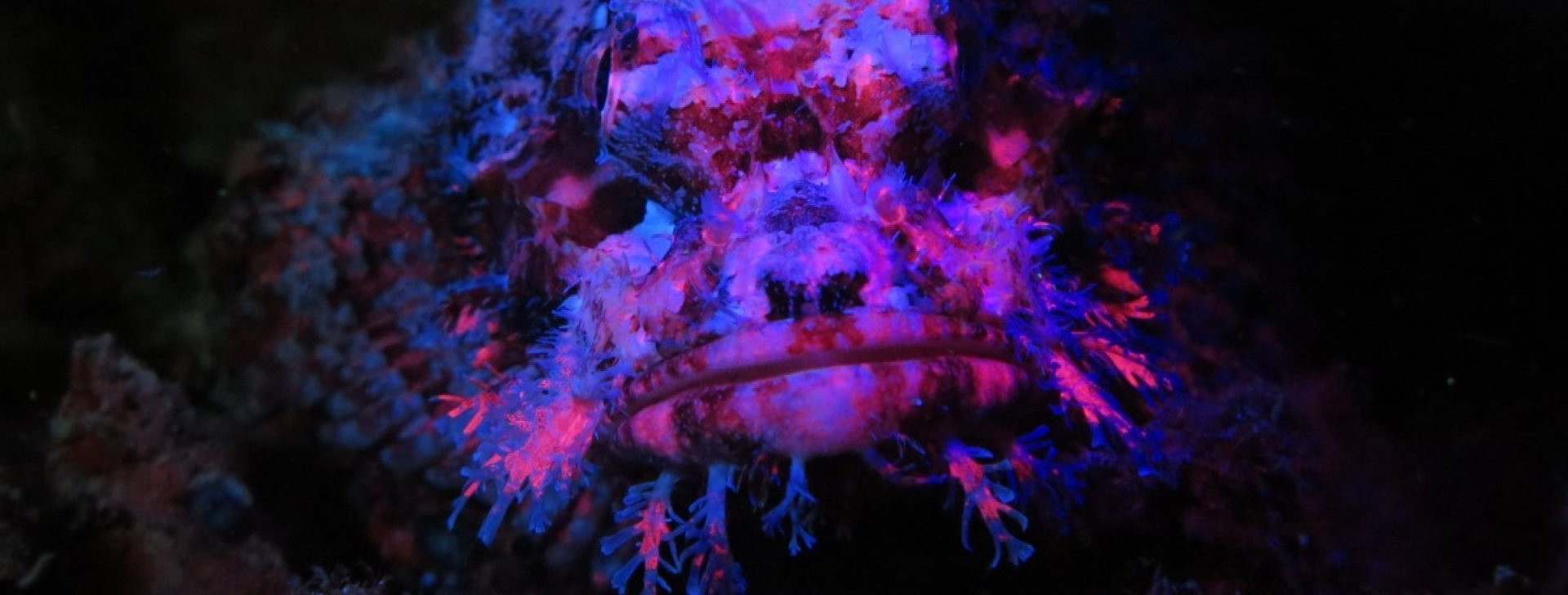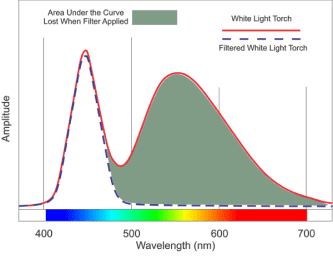
At FireDiveGear.com, (FDG) we very often get requests for an excitation filter to place over a white light source (torch). This is certainly a reasonable request. Who wants to spend more money for a dedicated fluo torch when you can modify an existing model you already own? While it is certainly possible to use a filtered – white light source, it is not recommended. This paper will endeavor to explain just why it is we don’t recommend a filtered – white light source.
Often, the customer’s first response to our recommendation is that we are just trying to sell them a more expensive blue light when, in fact, a dedicated blue torch can cost less than the filter required to turn a white light into a blue (fluo) light so that can’t be our motivation.
I will try to keep the science jargon and “technobabble” to a minimum but to fully explain what is actually going on does requires a small degree of scientific understanding. Let’s get started:
White light is made up of all the colors of the visible spectrum from deep violet (almost black), to violet, blue, green, yellow, orange, red to deep red (almost black) and an infinite number of hues in each primary color. Figure 1 below is an example of the light from the sun displayed on a device called an optical spectrometer.
The vertical axis of Figure 1 shows the relative amplitude or “strength” (irradiance) with respect to each color (wavelength).
Observe in Figure 1 that the peak amplitude is about 480nm. We all know from our entry level diving course that the first color that disappears in the water is red, then orange, yellow, green, and ultimately all that is left is blue. Most Ultra Violet (UV) is reflected off the water surface and that which is not reflected, doesn’t penetrate more than a few meters into the water. Marine organisms have evolved over the millennia in blue light which is why some will fluoresce so dramatically when exposed to blue light but the details of that are the topics of a different paper. The point here is why we use blue light in the first place.
As a side note UV torches also will cause some marine organisms to fluoresce but research has shown that to get the greatest observable effect, blue light in the range of 450 to 480 nanometers is best. A nanometer (nm) is 1 billionth of a meter of wavelength. Also note that it is well understood that UV light is bad for your eyes not to mention the poor creatures you shine it on underwater.
We are now going to look at some generic unfiltered and filtered torch spectrometer results to see what their output characteristics looks like.
Figure 2 above is the output from a name brand Xenon torch. This torch has a “warm”, “yellowish” hue. This should be no surprise since the peak is at 630 nm which is in the center of the yellow portion of the band. But notice what happens when you apply a notch excitation filter over the torch in Figure 3. You just eliminated a huge portion of the total output energy.
Figure 4 is the output from a name brand HID torch. This is a second example of what happens when you add the filter. Note here that there are many peaks in amplitude. This image shows that there is a great deal of “noise” in the signal but once again there is a large amount of “content” above 500nm. As a side note, Figure 4 and Figure 2 illustrate why all incandescing bulb torches look yellow. Again, in Figure 5, see what happens to all the energy when a filter is applied.
Figure 6 below is the output from a name brand LED torch and is our last example to drive the point home. This LED torch has a dramatically different output spectrum and this is characteristic of most LED torches. This is the reason their output appears more “cool” rather than “warm”; they have more blue content inherently.
The answer to that question is there is a great deal of content all over the spectrum and this is the key to the problem when using a “notch” filter to block all but the blue on a white light torch.
The total energy content (what you perceive as brightness) is the area under the curve or integral of the waveform. If you block everything but the blue you will indeed get a torch that will cause fluorescence in marine creatures. The problem is that you are “throwing away” all that other energy and hence will have a very dim blue torch.
With most white light torches you are throwing away 60%-80% (sometimes more) of the total energy output of the light source.
At FDG, we make torches that use blue LEDs that operate in the optimal fluorescing band of light and 100% of the energy content is located in that “notch” band. That means you will have dramatically more luminosity with a blue LED torch, all other factors being equal.
It must be noted that even on our blue torches we still use a custom designed dichroic excitation filter. This filter actually “fine tunes” the output from the LEDs to create better fluorescence and much better photo color saturation.
Additionally, our barrier filters (both mask and camera) are tuned to the characteristics of the light source to optimize the overall color characteristics of the entire “system”. This is why we can claim and show such dramatic images on our Gallery page: http://firedivegear.com/gallery/
At this point, you may be wondering how we deal with strobes. They are white light sources too and no one (to our knowledge) makes a blue light strobe. How do we argue this point and justify using a filter on a white light strobe source?
Actually we have the same problem with strobes. The good news is that strobes by their nature put out a great deal of light. When you lose 80% of the power from a strobe you still have plenty of light to make macro fluo shots. However, if you are using a puny strobe that is marginal for any type of distance white light shot, you will run into the same problem as outlined with torches. The bottom line is that if you intend to do fluo strobe photography, you need a powerful strobe and filter combination.
As a summary, see Figure 8 below for a schematic representation of the above discussion.

The Red line is the spectral plot of an actual Tekna T6 torch. The blue dashed line is the same torch with a dichroic filter placed on front. The green shaded color is the area under the red curve (integral) that represents the 80% in total output energy that is lost by placing the filter over the white light torch.
Lynn Miner
Physicist
01/2015
If you have any questions, comments or suggestions – PLEASE don’t hesitate to contact us.